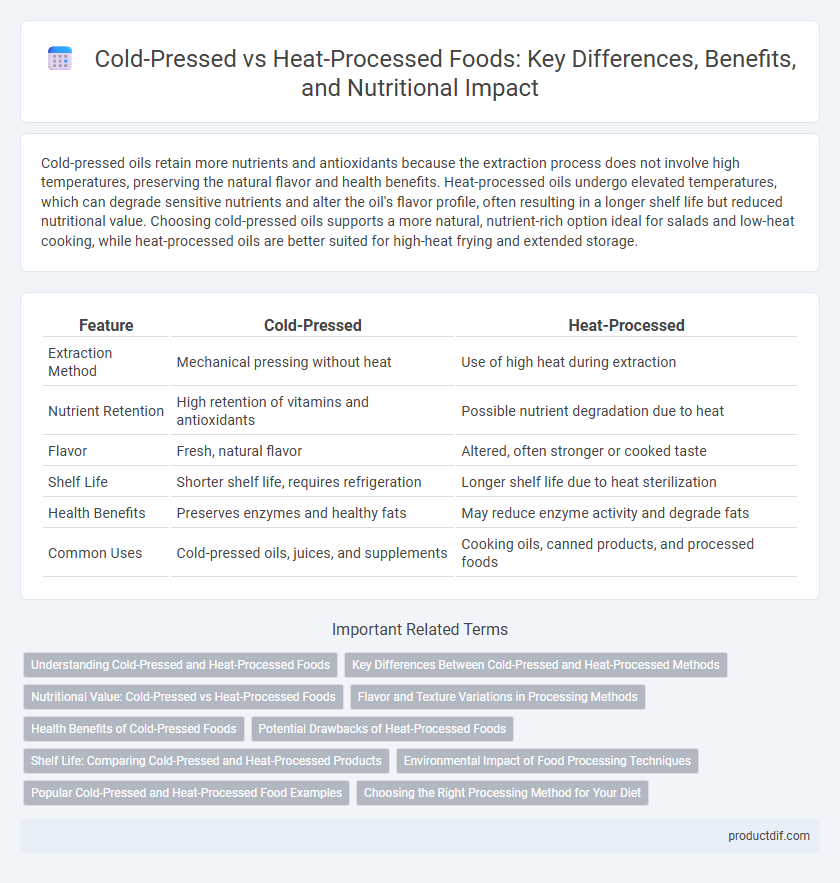Cold-pressed oils retain more nutrients and antioxidants because the extraction process does not involve high temperatures, preserving the natural flavor and health benefits. Heat-processed oils undergo elevated temperatures, which can degrade sensitive nutrients and alter the oil's flavor profile, often resulting in a longer shelf life but reduced nutritional value. Choosing cold-pressed oils supports a more natural, nutrient-rich option ideal for salads and low-heat cooking, while heat-processed oils are better suited for high-heat frying and extended storage.
Table of Comparison
| Feature | Cold-Pressed | Heat-Processed |
|---|---|---|
| Extraction Method | Mechanical pressing without heat | Use of high heat during extraction |
| Nutrient Retention | High retention of vitamins and antioxidants | Possible nutrient degradation due to heat |
| Flavor | Fresh, natural flavor | Altered, often stronger or cooked taste |
| Shelf Life | Shorter shelf life, requires refrigeration | Longer shelf life due to heat sterilization |
| Health Benefits | Preserves enzymes and healthy fats | May reduce enzyme activity and degrade fats |
| Common Uses | Cold-pressed oils, juices, and supplements | Cooking oils, canned products, and processed foods |
Understanding Cold-Pressed and Heat-Processed Foods
Cold-pressed foods retain more nutrients and enzymes because they undergo minimal heat exposure during extraction, preserving vitamins such as C and B-complex. Heat-processed foods, including pasteurized juices and canned vegetables, often experience nutrient degradation due to prolonged high temperatures but benefit from increased shelf life and safety. Understanding the differences helps consumers prioritize freshness and nutritional value in cold-pressed options or enhanced preservation in heat-processed products.
Key Differences Between Cold-Pressed and Heat-Processed Methods
Cold-pressed methods involve extracting oils or juices at low temperatures to preserve nutrients, enzymes, and flavors, resulting in higher quality and more natural products. Heat-processed techniques use elevated temperatures that can degrade sensitive nutrients but extend shelf life and improve microbial safety. The primary difference lies in nutrient retention, with cold-pressed maintaining maximal bioactive compounds while heat-processed emphasizes stability and preservation.
Nutritional Value: Cold-Pressed vs Heat-Processed Foods
Cold-pressed foods retain higher levels of vitamins, enzymes, and antioxidants due to minimal heat exposure during processing. Heat-processed foods often experience nutrient degradation, particularly of heat-sensitive vitamins like vitamin C and certain B vitamins. Choosing cold-pressed options ensures maximum preservation of essential nutrients, enhancing overall dietary quality.
Flavor and Texture Variations in Processing Methods
Cold-pressed oils retain a robust, fresh flavor and a natural, smooth texture due to minimal heat exposure, preserving sensitive aromatic compounds and nutrients. Heat-processed oils undergo higher temperatures, which can diminish delicate flavors and often result in a more neutral taste and lighter texture. Flavor profiles in cold-pressed products are generally richer and more complex, while heat-processed counterparts may offer consistency and longer shelf life with subtle texture differences.
Health Benefits of Cold-Pressed Foods
Cold-pressed foods retain higher levels of vitamins, enzymes, and antioxidants compared to heat-processed counterparts, promoting better nutrient absorption and overall health. The minimal heat exposure preserves essential fatty acids and phytochemicals, which support heart health and reduce inflammation. Studies show cold-pressed oils and juices enhance digestion and boost immune function due to their superior nutrient density.
Potential Drawbacks of Heat-Processed Foods
Heat-processed foods often experience nutrient degradation, leading to reduced levels of vitamins, enzymes, and antioxidants essential for health. High temperatures can also produce harmful compounds such as acrylamide and advanced glycation end-products (AGEs) that may contribute to inflammation and chronic diseases. Furthermore, heat processing can alter the natural flavor and texture of foods, diminishing their overall quality and nutritional value.
Shelf Life: Comparing Cold-Pressed and Heat-Processed Products
Cold-pressed products retain more natural enzymes and nutrients but generally have a shorter shelf life, typically ranging from a few days to a few weeks due to minimal preservation methods. Heat-processed foods undergo pasteurization or sterilization, extending shelf life to several months by eliminating bacteria and enzymes that cause spoilage. Consumers seeking longer storage or convenient pantry staples may prefer heat-processed options, while those prioritizing freshness and nutrient density often choose cold-pressed items despite their limited shelf longevity.
Environmental Impact of Food Processing Techniques
Cold-pressed food processing methods consume significantly less energy compared to heat-processed techniques, resulting in a lower carbon footprint and reduced greenhouse gas emissions. Heat-processed foods often require high temperatures and longer processing times, increasing energy consumption and contributing to environmental degradation through higher fossil fuel usage. Choosing cold-pressed products supports sustainable food systems by minimizing resource depletion and promoting eco-friendly manufacturing practices.
Popular Cold-Pressed and Heat-Processed Food Examples
Cold-pressed foods like virgin olive oil, raw almond butter, and fresh cold-pressed juices retain more nutrients and antioxidants due to minimal heat exposure. Heat-processed foods such as canned tomatoes, pasteurized milk, and roasted coffee beans undergo high temperatures to extend shelf life and enhance flavor, though some nutrient loss occurs. These methods distinctly influence food texture, taste, and nutritional profile, shaping consumer preferences and food quality.
Choosing the Right Processing Method for Your Diet
Cold-pressed foods retain more nutrients, enzymes, and antioxidants due to minimal heat exposure, making them ideal for nutrient-dense diets. Heat-processed foods often have a longer shelf life and enhanced flavors, suitable for those prioritizing convenience and taste. Choosing between cold-pressed and heat-processed depends on dietary goals, such as maximizing nutrient intake or balancing flavor and storage needs.
Cold-pressed vs Heat-processed Infographic

 productdif.com
productdif.com